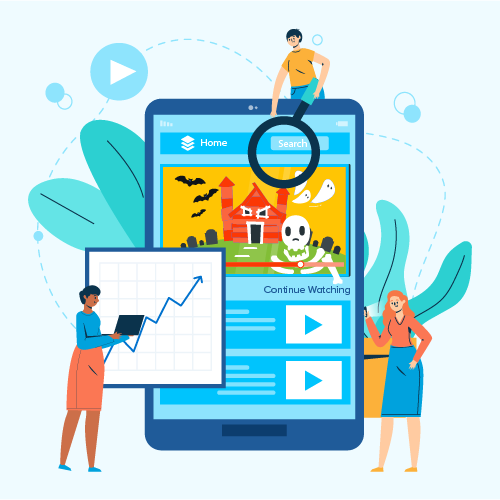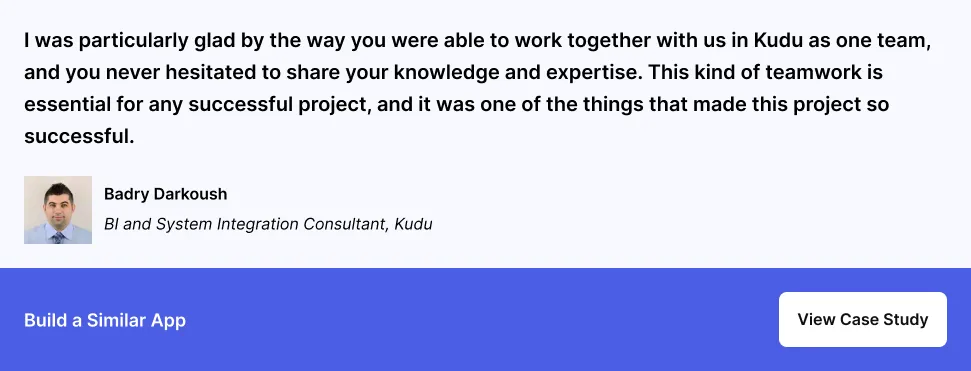- Understanding Cross-Platform App Development Frameworks
- Features of Cross-Platform Development Framework
- Single Codebase
- Native-Like Performance
- Pre-Built UI Components
- Fast Iteration Hot Reload
- Plugin and API Support
- Community and Documentation
- Scalability and Maintenance
- What are the Best Frameworks For Developing Cross-Platform Mobile Apps?
- Ionic
- React Native
- Flutter
- Xamarin
- NativeScript
- Node.js
- Appcelerator Titanium
- PhoneGap
- Sencha Touch
- Corona SDK
- Kotlin Multiplatform
- Framework 7
- .NET MAUI
- Qt
- Tauri
- Capacitor
- Electron
- Cross-Platform Mobile App Development Frameworks – A Quick Comparison
- Frameworks on the Decline: What to Avoid in the Future
- Apache Cordova / PhoneGap
- Appcelerator Titanium
- NativeScript
- jQuery Mobile
- What are the Benefits of Cross Platform Development Frameworks?
- Maximum Exposure to the Target Audience
- Reduced Development Cost
- Easier Maintenance & Deployment
- Quicker Development Process
- Reusable Code
- Easy Integration with Cloud
- Key Decision Factors for Framework Selection
- Project Requirements
- Performance Needs
- Community and Support
- Cost Efficiency
- Development Team’s Speed and Expertise
- Integration Capabilities
- Security Features
- Long-Term Maintenance and Updates
- UI/UX Capabilities
- Common Mistakes to Avoid in Framework Selection
- Choosing Based on Popularity Alone
- Ignoring Community Support and Documentation
- Neglecting Long-Term Maintenance
- Failing to Consider Platform-Specific Needs
- Underestimating Learning Curve and Developer Skillset
- Failure to Assess Third-Party Integrations
- Concentrating on Development Speed Alone
- Cross-Platform App Development Future Trends
- AI-Powered App Features
- Improved Native-Like Performance
- Integration with the Emerging Technologies
- Low-Code and No-Code Development
- Focus on Security and Compliance
- Start Building High-Impact Cross-Platform Apps with Appinventiv
- FAQs
Key takeaways:
- Cross-platform application development frameworks will also save you time and costs since the same code can be used to run on different platforms.
- Each of the popular frameworks, such as Flutter, React Native, and Ionic, has its advantages and disadvantages; thus, knowing the difference between them is the key to making the correct decision.
- The choice that you make ought to be informed by your project needs, team experience, and the degree of performance or UI customization that you require.
- The correct framework can guarantee an appropriate user experience and easy maintenance that will make your app a success on all devices.
Building apps today is no longer about choosing between Android and iOS. It’s about reaching everyone, everywhere, without doubling your workload. That’s where cross-platform app development frameworks come in.
Cross-platform app development has its own merits, which play a major role in its current popularity. With the expansion of its reach, several cross-platform app development tools and frameworks began to emerge in the market, first slowly and then all at once, alongside every other mobile app development company trying their hands at this intriguing and unique technology.
The result? We now have a sea of such tools and frameworks, which you, as a developer, may find overwhelming. To assist you in your search for the most suitable and outstanding cross-platform framework, we’ve compiled a list of the top cross-platform app development frameworks. These frameworks, including Node.js, React Native, Flutter, and PhoneGap, among others, are excellent choices for product development.
These frameworks are based on JavaScript. Hence, having a good grip on JavaScript is very important before moving ahead. Consider completing some free online courses to get a solid grip on the fundamentals.
Now, before diving into the details of multiple cross-platform frameworks and how they can benefit your development process, let’s first take a moment to understand what cross-platform app development is.
Understanding Cross-Platform App Development Frameworks
To be concise, cross-platform is a type of software that has the ability to run on multiple computing platforms, i.e., Android, iOS, Windows, Blackberry, etc. The apps built on this framework do not require separate coding for each platform; rather, coding once will create the foundation for the app to run as efficiently on all platforms. It is one of the most popular methods in the app development domain today, which almost all the top mobile app development services companies swear by.
To further elaborate, cross-platform app development companies specialize in creating versatile and efficient applications that work seamlessly across different operating systems. By utilizing advanced mobile frameworks and tools, these IT consulting firms can reduce development time and costs while ensuring a consistent user experience across all platforms.
Features of Cross-Platform Development Framework
Cross-platform app development frameworks come equipped with various advantages that enable the construction of apps across several platforms, making them more economical and uniform. Key features include:
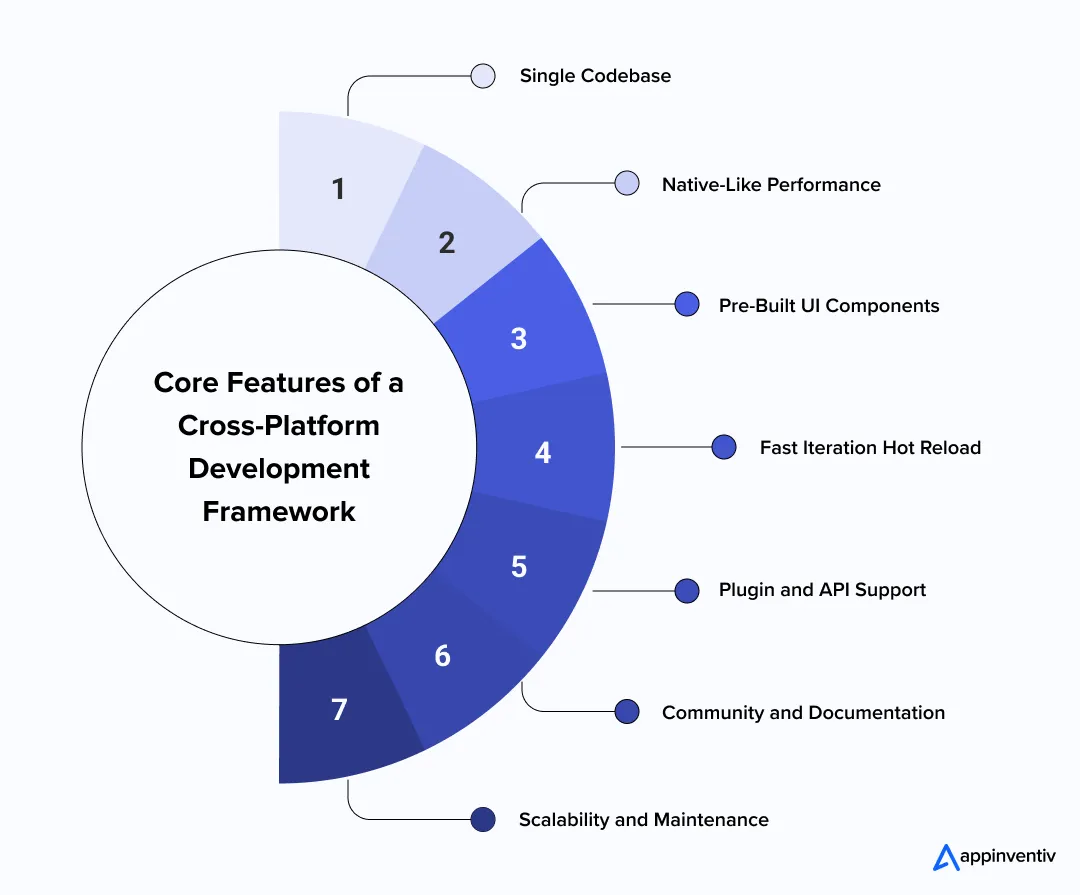
Single Codebase
An app framework enables a developer to create one codebase that can be executed on various platforms. This saves on development time, makes it easier to maintain, and ensures the devices maintain the same functionality and design.
Native-Like Performance
Modern cross platform mobile application development frameworks are developed in a manner that provides performance that is similar to native applications. They maximize the performance of rendering, memory utilization, and the activities that are specific to the device to deliver seamless user experiences to cross-platform applications.
Pre-Built UI Components
The majority of them include pre-built UI components and templates, which allow developers to build polished and responsive interfaces in a short time. These parts can be modified to suit brand requirements and app needs.
Fast Iteration Hot Reload
Flutter and React Native frameworks also have the hot reload feature, which can make changes visible to a developer as they develop. This speeds up the development, testing, and debugging.
Plugin and API Support
Cross-platform app development frameworks generally have wide libraries, plugins, and APIs. These assist in integrating with third-party services, device hardware, and cloud platforms, without the need to develop the functionality.
Community and Documentation
It boasts a strong developer community and comprehensive documentation, making it easier to troubleshoot issues, follow best practices, and stay updated on new features.
Scalability and Maintenance
Cross platform web app development is useful in simplifying the development of web apps that will be cross-platform because they can be improved on all platforms at once. This maintains consistency, lowers technical debt, and contributes to the app’s growth in the long term.
Appinventiv’s Insights
When selecting a cross-platform framework, prioritize features that align with your project goals and team expertise. Focus on performance, scalability, and the availability of pre-built components to speed up development while maintaining a native-like user experience.
What are the Best Frameworks For Developing Cross-Platform Mobile Apps?
Choosing the right framework can define the success, performance, and scalability of your mobile application. The best cross-platform app development frameworks combine flexibility, speed, and near-native performance while reducing overall development effort. Here are some of the most trusted and widely adopted frameworks for cross platform mobile app development in 2025 and beyond.
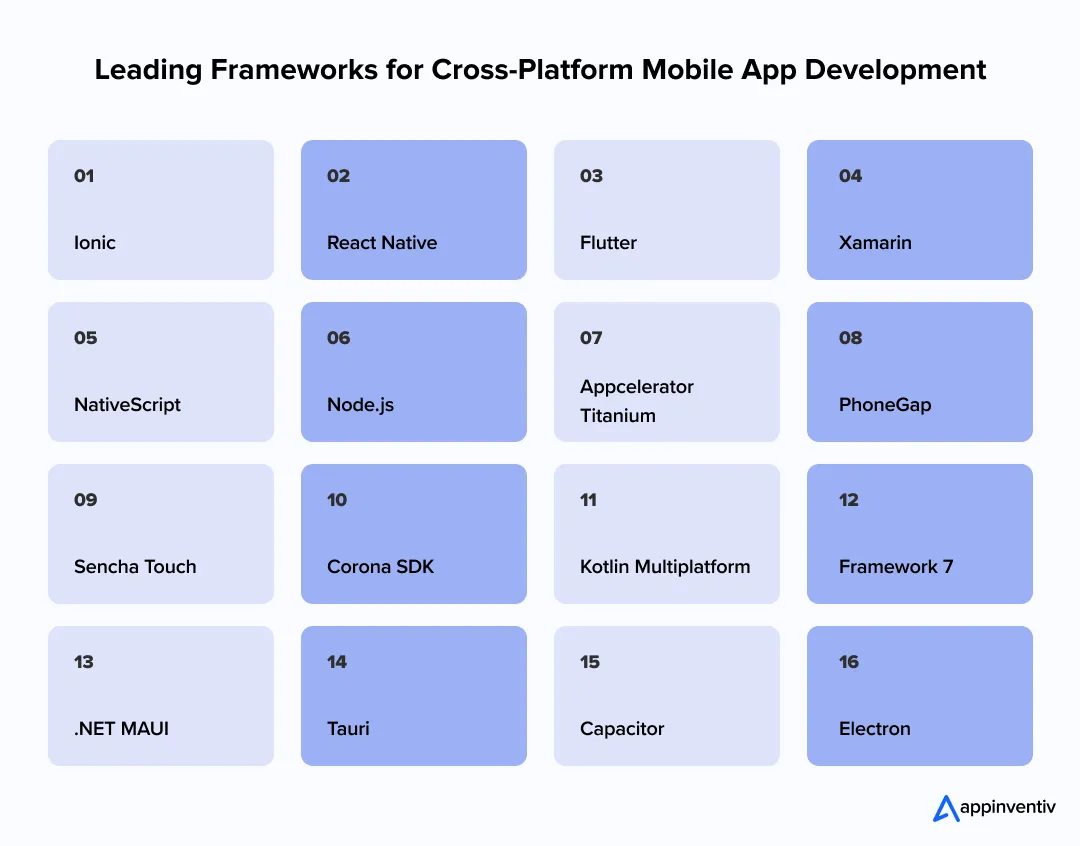
Ionic
Ionic is one of the most remarkable and popular cross-platform app frameworks, based on AngularJS. It allows developers to use a combination of top programming languages i.e., HTML5, JavaScript, and CSS, and Cordova wrapper to access native platform controllers.
Ionic enables developers to create an impeccably creative user interface, along with adding user-friendly features to the app. Apps developed with this framework are highly interactive and native-like, making Ionic a perfect candidate for PWA development as well.
Features
- Ionic is based on a SAAS UI framework designed specifically for mobile operating systems. It provides numerous UI components for developing robust applications.
- Another one of its most-appreciated features is that it is based on AngularJS, making it easy to offer extensions to HTML’s syntax, core functionalities to imbibe useful yet attractive features and components into the app.
- This framework uses Cordova plugins, which allow access to devices’ in-built features, including Camera, GPS, and Audio Recorder, posing as one of the major benefits of cross-platform development tools.
- The fact that Ionic gives a native-like feel to the apps is what makes it a favorite of developers. It helps develop cross-platform apps and allows them to perform perfectly on various platforms.
React Native
When talking about cross-platform app frameworks, it is hard not to include React Native. It is a framework built on JavaScript and is used to write real code and give a native-like feel to mobile applications that work both on Android and iOS. Due to its remarkable features, it is not only a preferred choice of developers, but businesses also trust React Native as the right platform for their apps.
React Native integrates the benefits of JavaScript and React.js, along with providing the advantage to developers to write modules in Objective-C, Swift, or Java. Moreover, by using the native modules and libraries in the React Native cross-platform apps, developers can also perform heavy operations such as image editing, video processing or some other operations which are not part of the framework APIs.
Features
- It is a good thing that React Native is an open-source cross-platform app framework, the same as Ionic. Because of this, it has a large community to support and improve it by fixing bugs and introducing features.
- One of the advantages of cross-platform development frameworks is that they require one-time coding (WORA) for developing apps for platforms as diverse as Android and iOS. This solves one of the biggest challenges of other frameworks, requiring developers to code separately twice for the same app on different platforms.
- One-time coding instantly reduces the app’s development time and keeps the React Native app development cost at its lowest.
- Impressively, React Native is highly compatible with third-party plugins, such as Google Maps.
- React Native focuses on UI to a great extent, rendering a highly responsive interface. What it means is that the React Native environment reduces loading time and delivers a smooth interface to the applications.
Flutter
Google introduced an impressive cross-platform app framework named Flutter back in 2017. It is a software development kit designed to assist in the expeditious Android and iOS app development. It is also a fundamental and primary method for developing Google Fuchsia apps.
Flutter offers apps that easily and effectively run on multiple platforms with uniformity and dynamism.
Here are some of the remarkable features that make Flutter an ideal cross-platform framework among developers.
Features
- Flutter promotes portable GPU, which renders UI power, allowing it to work on the latest interfaces.
- Flutter does not require updating the UI contents manually, as it possesses a reactive framework. Flutter app developers are only required to update the variables, and the UI changes will be visible after that.
- Flutter cross-platform app framework poses as a perfect choice for developing Minimum Viable Product (MVP) as it initiates an expeditious development process and is also cost-efficient.
- The developers can efficiently remake a widget tree automatically and comprehend the code adjustments.
- Flutter has an inbuilt graphic engine. Along these lines, the developers would not have the headache of making separate interfaces for Android and iOS.

Xamarin
Xamarin cross-platform app development frameworks are significantly different from the frameworks we have discussed so far. It is a streamlined framework used for developing apps for Android, Windows, and iOS with the help of C# and .Net, instead of JS libraries and HTML. It allows the developers to use 90% of the code for building an app for three distinct platforms.
Xamarin delivers applications with aesthetics similar to a native app using its amazing APIs, making the decision between Xamarin and React Native much harder. Here are Xamarin’s features explaining why it is one of the best choices for cross-platform development tools.
Features
- Apps developed on the Xamarin framework are built using C# – a modern cross-platform app development language that leverages over Objective-C and Java.
- The developers get native-level app functionality with Xamarin. It reduces hardware compatibility problems to a great extent with the help of plugins and specific APIs that work with common device functionality.
- It also promotes linking with native libraries, allowing customization and native-level functionality. The feature alone makes it one of the top Android app development frameworks.
- Xamarin supports the direct inclusion of Objective-C, Java, and C++ libraries. This allows developers to reuse many third-party codebases encrypted in Java, Objective-C, or C++, making it one of the best cross-platform frameworks.
- Xamarin reduces the time and cost of mobile app development because it supports the WORA ( Write Once, Run Anywhere) and has a humongous collection of class libraries.
- Xamarin offers robust compile-time checking. Because of this facility, developers witness fewer run-time errors and get well-functioning apps.
- Xamarin has an astounding native user interface and controls, assisting and allowing developers in designing a native-like app.
NativeScript
NativeScript passes as an amazing free cross-platform framework based on JavaScript. It wouldn’t be wrong to say that NativeScript is a preferable choice for developers looking for WORA functionality.
NativeScript also offers all native APIs, enabling developers to reuse existing plugins straight from NPM in their projects.
Features
- NativeScript renders beautiful, accessible, and platform-native UI, and that too without the WebViews. Developers are only required to define once and let NativeScript adapt to run everywhere. They can even customize the UI to specific devices and screens.
- As opposed to React Native, NativeScript provides developers with a complete web resource that comes loaded with plugins for all kinds of solutions. This inevitably eliminates the need for third-party solutions.
- NativeScript gives the freedom to access native Android and iOS APIs easily, meaning developers don’t need any additional knowledge of native development languages.
- It uses Angular and TypeScript for programming purposes.
- NativeScript supports segments like Cocoapods and Android Arsenal and calls local strategies from libraries.
Node.js
Node.js is an incredible framework for developing cross-platform apps. Essentially, Node.Js is a JavaScript runtime framework built on the Chrome V8 JavaScript engine. It is an open-source environment that supports the development of server-side and scalable networking apps. Node.js cross-platform apps are inherently highly efficient and responsive.
The framework is capable of handling several concurrent connections. It also comes loaded with a rich library of numerous JavaScript modules that help in simplifying the development of web applications.
Features
- All Node.js APIs are asynchronous, meaning they are non-blocking, so servers based on Node.js do not essentially wait for data from APIs.
- It immediately moves on to another API after calling it. A notification mechanism for Node.js allows the server to get a response from the previous API call.
- Node.js library is impressively speedy in its code execution process, for it is built on Chrome’s V8 engine.
- Node.js cross-platform apps do not buffer; instead, the applications output the data in chunks.
- To deliver smooth and perfectly functioning applications, Node.js uses a single-threaded model with event-loop functionality. This event mechanism enables the server to reply in a non-blocking way, making it scalable.
- Node.js applications lessen reaction time for slow requests, and every developer can execute all the information inquiries at the same time.
Appcelerator Titanium
Appcelerator is one of the many cross-platform app development tools designed to assist in smoother and easier mobile app development. It is a great way to create cross-platform apps with just a single code base. Its primary focus is on streamlining the app development process with the help of native components present in JavaScript code.
Features
- Appcelerator offers various tools for rapid application development. This indicates that a prototype can be created with much less time and effort to evaluate user interaction with UI.
- It has ArrowDB, a schema-less data store that allows developers to deploy data models with no additional effort for setup.
- It enables the integration of existing continuous delivery systems, such as SCM solutions, and more.
- Appcelerator possesses pre-built connectors available for MS Azure, MS SQL, Salesforce, Box- the list is tediously long.
PhoneGap
Phone Gap (Cordova) is one of the impeccable cross-platform frameworks for mobile development that makes use of CSS, JavaScript, and HTML5. It also offers a cloud solution to developers, providing them with the choice to share the app in the development process for feedback from other developers.
It develops impressive apps by leveraging existing web technologies. Another great advantage of PhoneGap is that it entirely supports built-in device features such as GPS, Camera, Phonebook, Storage, and so on.
Features
- PhoneGap is considered an impeccable cross-platform framework as it enables developers to create cross-platform apps using existing web technologies such as HTML5, CSS3, and JavaScript.
- Being a cross-platform framework, PhoneGap supports the use of a single code base to create apps for different platforms, namely iOS, Android, Windows Phone, BlackBerry, etc.
- It follows an architecture that is plugin-able in nature, meaning it is possible that access to native device APIs can be extended in a modular way.
Sencha Touch
Introduced nearly a decade ago, Sencha Touch helps in developing web-based cross-platform apps and is typically used to create efficient applications that use the hardware acceleration techniques. By using Sencha Touch, developers are able to create well-tested, securely integrated UI components and libraries.
In fact, it is possible to develop large business apps and maintain them effectively and easily. Some of the remarkable features of it are:
Features
- It is famous for providing built-in native-looking themes for all of the major platforms, like Android, iOS, BlackBerry, Windows Phone, etc.
- It comes with an effective agnostic backend data package for working with data sources.
- One of the most celebrated features of Sencha Touch is that it supports Cordova integration for native API access, along with the packaging.
- It offers code compatibility between the new and old ones.
- It comes loaded with customizable and 50+ built-in UI widgets. It also has a collection of rich UI, like lists, carousels, forms, menus, and toolbars etc., created specifically for mobile platforms.
Corona SDK
Corona SDK enables programmers to develop 2D mobile applications for all the major platforms, including Kindle and Windows. It offers 10X faster mobile and game app development. The framework delivers remarkable results due to its backend framework’s reliance on Lua, a lightweight and multi-paradigm programming language.
The language focuses on the main elements of development: speed, portability, extensibility, scalability, and, last but not least, ease of use. What is more, it is a free-of-cost framework working both on Mac OS X and Windows while supporting real-time testing.
Features
- It has over 1000 APIs that give developers the ability to sprite animations, audio, and music, Box2D physics, object tweening, texture management, native elements, and data- the list can go on for pages.
- It responds to the code changes almost instantly while giving a real-time preview of the app’s performance as it would on a real device.
- It supports almost 200 plugins, including in-app advertising, analytics, media, and hardware features.
- Corona SDK depends on the Lua programming language, which makes the framework quick and powerful.
Kotlin Multiplatform
Kotlin Multiplatform, developed by JetBrains, extends the Kotlin language to enable developers to write shared code that runs on both Android and iOS. Launched as a part of Kotlin since 2017, it has been steadily gaining traction for its ability to provide a genuine shared codebase experience while allowing for platform-specific implementations.
Features
- Kotlin Multiplatform allows developers to share the business logic layer across platforms, reducing duplication and maintaining consistency.
- Although the business logic can be shared, Kotlin Multiplatform enables the use of native UI components, ensuring that the app retains a look and feel that is consistent with the platform.
- It seamlessly integrates with existing Android and iOS projects, allowing developers to gradually adopt Kotlin for existing applications without a complete rewrite.
Framework 7
Framework7 is a free and open-source framework for developing mobile, desktop, and web apps with a native look and feel. It is also incredibly feature-rich and geared towards the creation of iOS and Android apps with a single code base.
Features
- Framework7 provides a wide array of UI elements and widgets, including lists, forms, cards, and smart select, which help in creating visually appealing and highly functional applications.
- Utilizing familiar technologies like HTML, CSS, and JavaScript makes Framework7 an accessible option for web developers looking to transition into mobile app development.
- It does not depend on React or Angular, although it can integrate with them if desired. This independence allows greater control over the app’s performance and behavior.
.NET MAUI
Multi-platform App UI (NET MAUI) is a framework introduced in the latest version that enables developers to develop cross-platform apps that run on Android, iOS, macOS, and Windows based on one codebase and C# and XAML. It works closely with Microsoft tools and thus makes it easier to develop apps and maintain them, particularly when the organization is already part of the Microsoft ecosystem.
Features
- NET MAUI provides a platform-independent shared UI and business logic and platform-specific customization.
- It also does not limit hardware capabilities as it supports native device APIs.
- Using one project structure, it is possible to roll out apps to mobile, desktop, and tablet devices.
- It makes maintenance and updates simple because it has centralized code, which minimizes duplication.
Qt
Qt is one of the most established cross-platform app development frameworks, which is also famous in terms of high performance and flexibility. It is a desktop, mobile, and embedded system application development platform written in C++ and QML. Qt is frequently employed with applications that need a smooth and native-like interface in cross-platform applications.
Features
- Qt enables platform-neutral development, which saves on development time.
- It offers state-of-the-art UI elements and hardware-based graphics.
- Qt has testing, deployment, and internationalization tools to support enterprise-grade applications.
- It is very customizable, allowing it to be integrated with other languages and frameworks.
Tauri
Tauri is a lightweight framework that allows developers to create secure cross-platform apps based on web technologies (HTML, CSS, JavaScript) and a Rust backend. It is small in size, fast performing, and highly secure, making it suitable for contemporary desktop applications.
Features
- The Rust core makes Tauri applications fast and memory-efficient.
- It also offers access to the native device API without enlarging the app.
- Popular frontend frameworks such as React or Vue can be used by developers to develop the UI.
- Tauri makes the packaging and distribution of Windows, macOS, and Linux simpler.
Capacitor
Ionic created Capacitor, a runtime that can be used to create cross platform web app development that is native. It enables web applications to utilize the capabilities of devices, like the use of the Camera, GPS, and Notifications, closing the divide between web and native applications.
Features
- Capacitor provides stable iOS, Android, and web APIs.
- It is compatible with such frameworks as Ionic, Angular, and React.
- Existing web code can be used by developers with native functionality added.
- It enhances debugging and reloading live to enhance development.
Electron
Electron allows web developers to create desktop cross-platform applications with web technologies such as HTML, CSS, and JavaScript. Technologies like Visual Studio Code or Slack show that they can be used to build full-fledged desktop apps using a single codebase.
Features
- Electron avails native desktop APIs and utilizes web technologies.
- It is compatible with Windows, macOS, and Linux.
- The architecture supports the addition of Node.js modules to support sophisticated functionality.
- Electron provides packaging systems to develop installers on all mainstream platforms.
Now, let’s move ahead and give you a crisp comparison of all the best cross-platform mobile app development frameworks available, each tailored to meet different project requirements and goals.
Cross-Platform Mobile App Development Frameworks – A Quick Comparison
This cross platform mobile development frameworks comparison will help streamline your selection process by outlining the advantages, limitations, and real-world applications of each framework, ensuring you can make an informed decision tailored to the specific needs of your mobile app development project.
| Framework | Pros | Cons | Examples |
|---|---|---|---|
| Ionic | Open-source, uses AngularJS, native-like feel | Performance can lag behind true native apps | MarketWatch |
| React Native | Write once for all platforms, strong community | Larger app size, complex UI can be challenging | |
| Flutter | High performance, Google’s UI toolkit | Relatively new, fewer third-party libraries | Alibaba |
| Xamarin | Native performance, uses C# | Larger app size, fewer updates | The World Bank |
| NativeScript | Direct access to Android and iOS APIs | Smaller community, steeper learning curve | RegelNeef |
| Node.js | Non-blocking I/O, suitable for scalable apps | Reliance on JavaScript, which can lead to less efficient handling of CPU-intensive tasks | PayPal |
| Appcelerator Titanium | Uses JavaScript, good for rapid prototyping | Declining community support, steep learning curve | Comerica |
| PhoneGap | Easy to use with web technologies | Performance issues, less native feel | Wikipedia |
| Sencha Touch | Rich UI components, good for large business apps | Limited to web-based, less community support | Audi A4 Drive |
| Corona SDK | Fast development, supports 2D gaming | Best suitable for games only | Angry Birds |
| Kotlin Multiplatform | Share code between Android and iOS, modern | Still evolving, limited libraries compared to others | Netflix |
| Framework7 | Full-featured, independent of React/Angular | Primarily focused on iOS-like design | CryptoWiz |
| .NET MAUI | Unified framework for Android, iOS, macOS, and Windows; backed by Microsoft | Limited third-party plugins compared to older frameworks | Microsoft To-Do |
| Tauri | Extremely lightweight, high security, builds small desktop apps | Limited mobile support, younger ecosystem | Volt |
| Capacitor | Easy integration with existing web apps, native plugin support | Performance can lag for graphics-heavy apps | Sworkit |
| Electron | Cross-platform desktop apps using web tech, strong community | Large app size, higher memory usage | Slack |
Frameworks on the Decline: What to Avoid in the Future
The mobile application marketplace is developing fast, and certain previously trendy tools are no longer relevant. Understanding the cross-platform app development frameworks that are on a decline can aid the developer in making improved long-term choices.
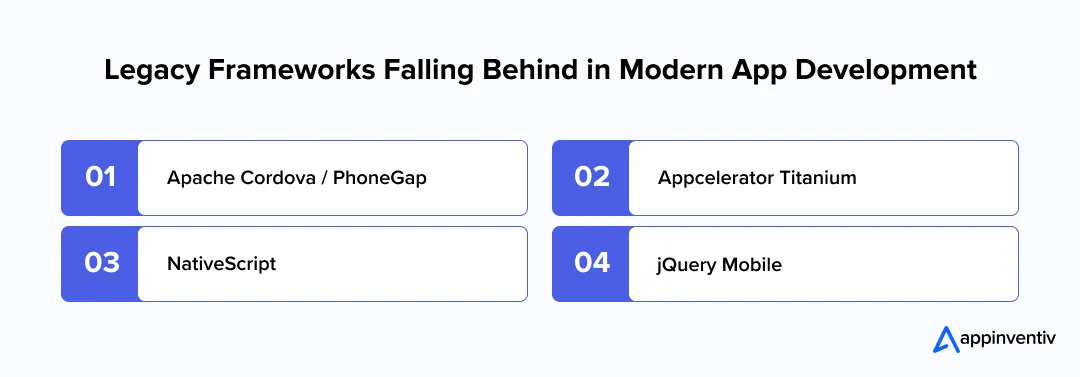
Apache Cordova / PhoneGap
These were the dominant hybrid frameworks based on web technologies with native shells around them. They started to fall when Adobe stopped supporting PhoneGap in 2020. Today, Flutter, React Native, and Capacitor are popular among developers due to the superiority in the performance of the UI and the reliability of their respective plugins.
Appcelerator Titanium
Titanium, which is known to map JavaScript to native components, was able to achieve almost native performance during its initial years. Nonetheless, less frequent community updates and slower development have caused developers to turn to more current, more robust frameworks.
NativeScript
Although NativeScript provides support for native rendering via JavaScript and TypeScript, its small ecosystem and limitations with regard to plugins have minimized its usage. Its market share is still declining as opposed to contemporary giants.
jQuery Mobile
jQuery Mobile is no longer popular, having been out of the lightweight web-based mobile applications. The majority of the teams have shifted to frameworks that enable responsive design and native level performance.
Appinventiv’s Insights
Sticking with declining technologies increases maintenance costs and limits scalability. Teams investing in cross platform mobile app development should migrate to supported frameworks that evolve with current OS and hardware updates.
What are the Benefits of Cross Platform Development Frameworks?
Cross-platform app development frameworks streamline the entire mobile development process by enabling faster deployment and wider reach with minimal effort. They help businesses maintain feature parity and design consistency across different platforms while optimizing resource use. Here are some of the top benefits of cross platform mobile app development frameworks for modern app projects.
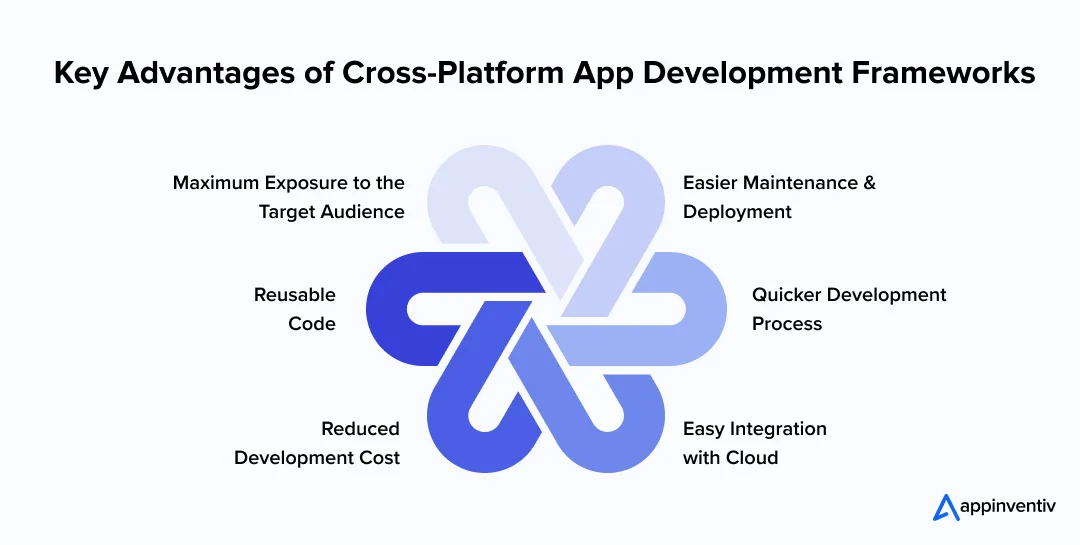
Maximum Exposure to the Target Audience
Utilizing a cross-platform mobile development approach empowers you to construct an application and send it to different platforms, including the web. This implies that by building a single application, one can target both iOS and Android platforms, hence expanding their range.
Reduced Development Cost
The cross-platform application development depends on the idea ‘compose once, run all over the place’. Reusable code and agile application development through tools can reduce the expense of development. In this manner, to improve your business on numerous platforms and tools in a practical manner, there is no other choice but to use cross-platform applications.
Easier Maintenance & Deployment
Since there’s just one developed application that runs on all platforms, it is simpler to keep up and also send code or changes made. Updates can be synced over all platforms and gadgets, consequently saving time and money. Besides, if a bug is found in the regular codebase, it ought to be fixed once. Along these lines, developers can save a great deal on time and money.
Quicker Development Process
The speedy development process is another mutually advantageous situation with regard to creating cross-platform applications. Single source code for multiple platforms can help diminish the development efforts by 50% to 80%. It assists you in getting a feature-rich business application in less time. The group of developers can fulfill the expected deadlines in cross-platform application development.
Reusable Code
Another beneficial thing about this platform is that the code can be utilized over and over. Rather than developers creating new code for each platform, a single code can be reused. This saves time and resources by eliminating repetition in the code-making process.
Easy Integration with Cloud
Cross-platform mobile applications are absolutely compatible and can exploit different plugins incorporated with the cloud settings. In other words, the single source code is composed of different plugins and extensions to improve the application’s scalability and usefulness.
Key Decision Factors for Framework Selection
Choosing the right cross-platform mobile app development framework is crucial for the success of your project. It can define the efficiency, performance, and user experience of your app, influencing both short-term development goals and long-term maintenance. Here are the factors that can impact your choice of the best cross-platform application development framework:
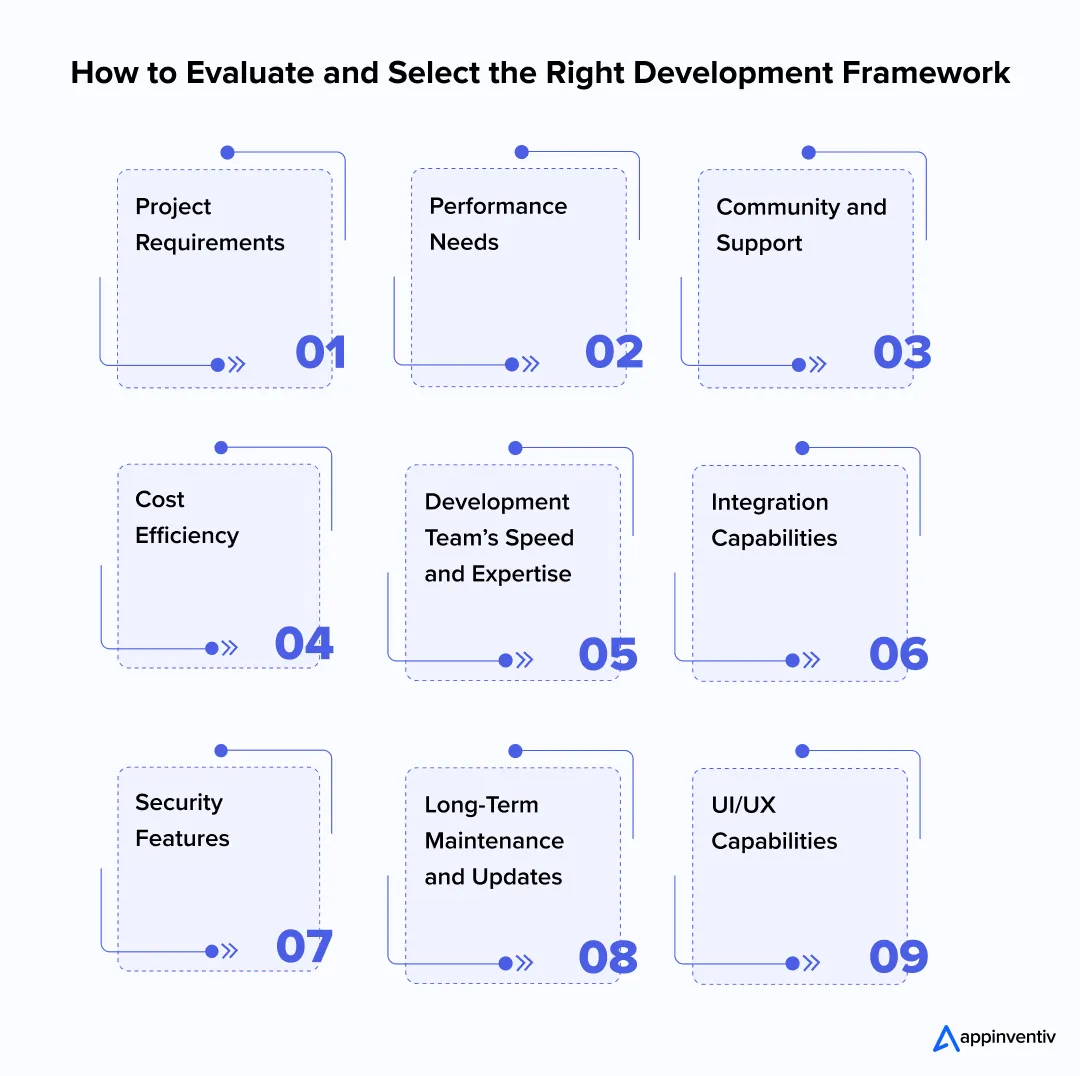
Project Requirements
Know the peculiarities of your project. Think about what kind of app you are creating, what functionality you require, and what degree of UI complexity would be required. Applications that have complex animations, hardware-intensive functions, or follow complex multimedia functionality may correspond better to some cross-platform app development frameworks as compared to others.
Performance Needs
Determine the importance of performance to your application. When your application needs close-to-native responsiveness and a native experience, select frameworks with reputations for close-to-native performance, e.g., Flutter or React Native. Cross-platform mobile app development frameworks differ in how they handle rendering, memory, and device-specific tasks.
Community and Support
Examine the magnitude and vitality of the framework’s community. A vibrant community of developers will offer more support, be easy to access, and be updated regularly, which is beneficial in the development and troubleshooting. Powerful community support will guarantee quicker resolution of the issue and availability of common best practices.
Cost Efficiency
Evaluate the cost-effectiveness of the framework. Some of the best cross-platform mobile app development frameworks save both time and money spent on development because they are write once, run anywhere. Others might be in need of special skills or extended development periods, which adds up to higher project costs.
Development Team’s Speed and Expertise
Evaluate how quickly your team can adapt to the chosen framework. The pace of cross-platform mobile app development often depends on familiarity and prior experience. Partnering with an experienced outsourcing team can accelerate delivery, reduce training time, and ensure smoother execution. However, adopting unfamiliar frameworks may increase development time, introduce errors, and raise overall project risk.
Integration Capabilities
Test the ease of integration with other third-party tools, APIs, and existing backend systems through the framework. A seamless integration facilitates making your app take full advantage of the key services and functionality, which improve the overall performance and user experience of the end product.
Security Features
Test the security settings of the framework. The presence of cross-platform mobile app development frameworks with the ability to encrypt, provide secure authentication, and secure data protection mechanisms aids in protecting the user data and allows adherence to the regulations.
Long-Term Maintenance and Updates
Look at the history of the framework updating and its compatibility with new OS versions. Using a properly maintained structure benefits in the long run, minimizes technical debt, and your app is always able to perform.
UI/UX Capabilities
Look at the tools that the framework uses to create responsive and interactive interfaces. An architecture that embraces platform-friendly UI components and platform-specific animation will enhance user experience, which is essential to adoption and retention.
The choice of the appropriate framework is not merely a matter of technique but a strategic decision that can influence the efficiency, performance, cost, and success of your services in creating cross-platform mobile applications in the long run.
Common Mistakes to Avoid in Framework Selection
The choice of the framework to use is a major determinant of the success of any application. It is possible to be aware of these mistakes and make the right decisions in the team, preventing the expensive traps. Making a wrong choice may lead to delays, high costs, and performance issues that could cause user experience problems. Here are some of the top mistakes to address.
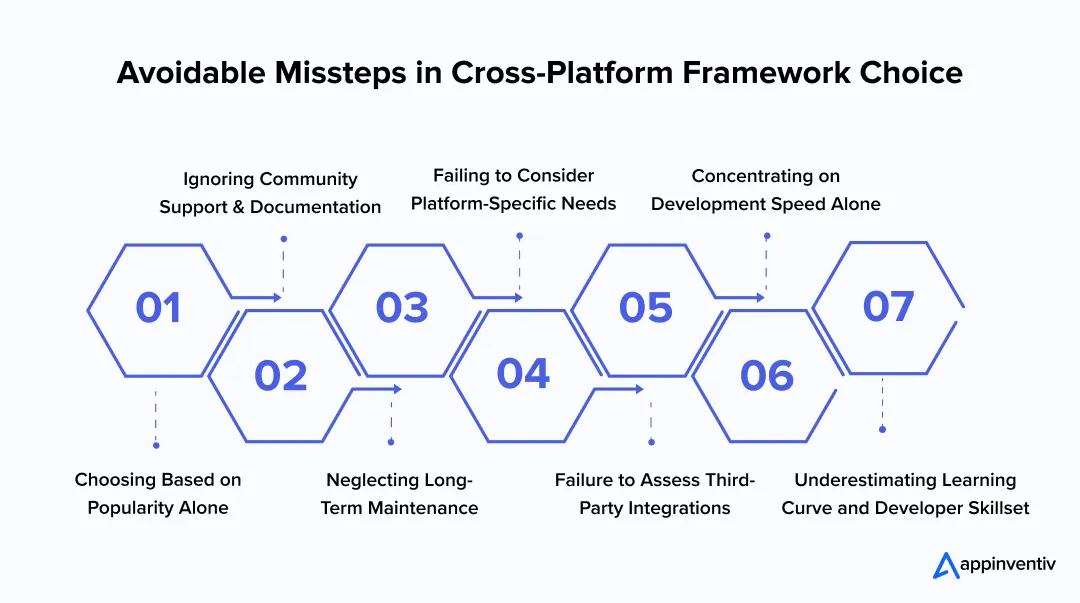
Choosing Based on Popularity Alone
Depending on the most fashionable paradigm may be counterproductive. One framework can be popular but may not fit your project requirements, performance needs, or supported platforms. A cross-platform mobile development framework comparison should help you determine which tools are most appropriate for your project’s aims, rather than just following the hype.
Ignoring Community Support and Documentation
Frameworks that have limited tutorials, have little documentation, or are experiencing a declining community can hamper development and end up making troubleshooting hard. The ideal choice of the best cross platform app development framework is one with an active community and extensive guidance that will help resolve the problems quickly and provide access to good practices.
Neglecting Long-Term Maintenance
Certain frameworks might be effective at first, but they do not keep up with the OS changes, security patches, or new devices. The lack of focus on maintainability increases the cost and the technical debt. This is because a framework with good longevity and periodic updates will be picked to ensure sustainable cross-platform mobile app development.
Failing to Consider Platform-Specific Needs
Android and iOS are not treated equally in all frameworks. The quality of the app can be affected by the disregard for platform-specific considerations of the UI and UX. When analyzing cross-platform app development frameworks, it is critical to evaluate the flexibility of the framework so that an app appears and functions as it should on all platforms.
Underestimating Learning Curve and Developer Skillset
Implementing a system that is not within your team could add more time to development and decrease productivity. Evaluate the expertise and training needs of developers and commit to a new tool. The appropriate framework is to be matched with team competencies and allow scalability and performance.
Failure to Assess Third-Party Integrations
The number of apps that are dependent on plugins or other libraries is high. A framework that has few third-party adherents can limit functionality or require elaborate workarounds. The ability to be compatible with necessary integrations is an important factor that can guarantee the process of development.
Concentrating on Development Speed Alone
The desire to build things quickly is intoxicating, yet focusing on short-term speed at the expense of maintainability and performance can lead to technical debt. An architectural design ought to have an equilibrium between the efficiency of development and long-term reliability, bwith less problematic refactoring and scalability in the future.
Let our team guide you to the right solution for faster, smoother development
Cross-Platform App Development Future Trends
As we approach the end of 2025, we can see how quickly the cross-platform app development landscape is changing. It is important that companies keep pace with these trends in order to maintain a competitive advantage. The following are the major developments to follow:
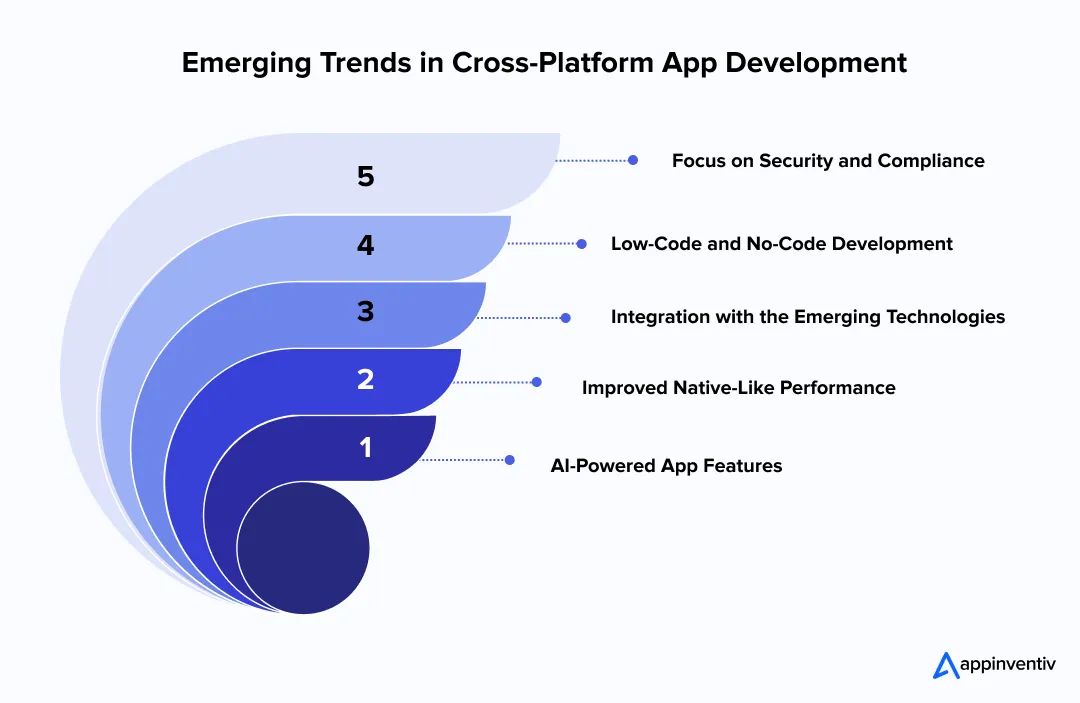
AI-Powered App Features
AI is improving the capabilities of apps by providing on-device processing, self-centric user experiences, and predictive analytics. Applications will be smarter and will learn their users, based on their behavior and anticipating their needs, which can be particularly handy when it comes to industries such as logistics, to optimize their operations in real-time.
Improved Native-Like Performance
Cross-platform systems such as Flutter and React Native are closing the performance gap to native applications, providing a high-performance system with GPU-accelerated rendering, effective memory management, and native integration between modules to provide a smooth and responsive user experience.
Integration with the Emerging Technologies
IoT, AR, and Blockchain are becoming more involved in cross-platform applications. This will provide an easy communication with smart devices, interactive experiences, and higher data protection, which such industries as logistics, healthcare, and finance will need to simplify operations and establish transparency.
Low-Code and No-Code Development
No-code/low-code platforms are the new democratic approach to app development ,allowing business leaders to prototype swiftly, save money, and empower non-coders to help in the creation of apps. This tendency gains momentum, innovation, and speed to market, specifically in startups and SME.
Focus on Security and Compliance
With the increased importance of data security, cross-platform frameworks are being integrated with end-to-end encryption, biometric authentication, and regulations like GDPR and others. Such solutions keep user information secure, and apps are of a high standard, which is essential in the industry where sensitive data is involved.
Start Building High-Impact Cross-Platform Apps with Appinventiv
Having considered the best frameworks, it is evident that the cross-platform development environment is not only vibrant but also competitive. All frameworks have their own advantages, and their adaptability will decide which instruments will prevail on the market, and the newcomers will constantly challenge the limits. Selecting the appropriate framework is not only about popularity today but also the ability to be scaled in the long run, perform, and meet the business objectives.
As a reputed mobile app development services company, we have more than 10 years of experience in developing high-impact cross-platform enterprise solutions for our global clients, including KFC, Domino’s, Pizza Hut, Adidas, HIPP, Kudu, and IKEA, to name a few.
These case studies highlight our ability to navigate complex requirements across industries, ensuring apps that are not only functional but also intuitive, visually engaging, and consistent across devices.
We are a reputable cross-platform mobile application development firm with a blend of technical expertise and insights into user behavior to increase the effectiveness and coverage of mobile solutions. By designing experiences custom to the specific goals of each business, our developers are able to guarantee compatibility with all platforms.
With Appinventiv, businesses can not only have an app but also gain a strategic partner who provides world-class, scalable, and future-ready mobile solutions that stand out in a competitive digital environment. Connect with our experts today to share your next project idea!
FAQs
Q. Which is better, native or cross-platform development?
A. The best cross-platform framework depends on your specific project needs, developer skills, and desired app features. React Native is often known for its robust community support and ability to allow developers to write apps with a native feel using JavaScript. On the other hand, Flutter is also highly regarded for its fast performance and beautiful UI capabilities.
To ensure successful implementation, partnering with a cross-platform mobile app development services provider can be your best bet, as they can help you tailor solutions that leverage the strengths of these frameworks.
Q. How do you make a mobile app cross-platform?
A. Well, the answer is as easy as cutting a pie. You can choose from a wide variety of cross-platform app frameworks available in the market. These frameworks ensure that your app is smooth functioning and is able to run just as efficiently on all platforms as a native app.
Moreover, the easiest way out of this would be to choose an impeccable cross platform mobile app development company with the experience and proper tech stack needed for effective app development.
Q. What are some of the top challenges in cross-platform app development?
A. Here are some of the challenges in cross-platform development and solutions to overcome those:
Performance Issues
Challenge: Cross-platform applications may perform more slowly than native applications because of additional layers of frameworks.
Solution: Implement performance-optimized structures, such as Flutter or React Native, and reduce heavy animations or libraries not necessary.
Limited Native Access
Challenge: There are frameworks that not only do not have access to the device-specific features entirely.
Solution: Use plugins or write custom native modules for Android and iOS to extend functionality.
UI/UX Inconsistency
Challenge: It is a challenge to bring a native appearance and feel across platforms.
Solution: Adhere to the design guidelines of individual platforms and apply adaptive UI elements of contemporary frameworks.
Obsolete Plugins and Dependencies
Challenge: Third-party extensions can cause a failure or loss of updates.
Solution: Use libraries that are well-maintained and keep them updated.
Q. Which language is best for cross-platform app development?
A. The best language for cross-platform app development depends on the framework and project needs. Dart (used in Flutter) is popular for its performance and native-like UI. JavaScript and TypeScript dominate with frameworks like React Native and Ionic. Kotlin and C# are preferred for Kotlin Multiplatform and .NET MAUI, respectively. Each balances flexibility, speed, and community support across leading cross-platform app development frameworks.


- In just 2 mins you will get a response
- Your idea is 100% protected by our Non Disclosure Agreement.

Unlocking the Cost of Building a Community Platform Like Qatar Living: What to Expect
Key takeaways: Building a community platform is a business decision first and a technology project second. A strong MVP in Qatar typically starts around QAR 109,200–QAR 254,800, while full-scale platforms move into the QAR 2,184,000+ range based on scale and ambition. Success comes from solving daily user problems, not from copying features. Cost is driven…

How to Build a Taxi Booking App in Australia: Process, Features, and Costs
Key takeaways: Australia’s shift toward app-based transport is growing fast, making this the right time for businesses to build scalable taxi booking platforms. A successful taxi app in Australia depends on strong compliance, real-time accuracy, and a modular backend that supports multi-city operations. Payments, GST-ready pricing, safety workflows, and state-wise licensing must be built into…

English-Arabic App Development: Key Business Challenges and How to Solve Them
Key takeaways: Localization is More Than Translation: Success in MENA requires adapting to RTL design, regional dialects, and cultural nuances, not just translating text. Strategic Localization is Key: Tailoring the app experience for MENA means choosing the right dialects, optimizing RTL navigation, and ensuring cultural relevance. Real-World Success Stories: Companies like Careem and Anghami succeeded…
























